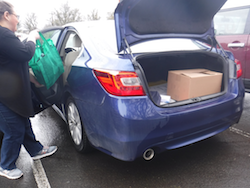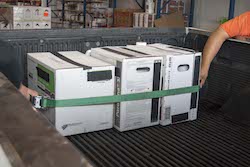What should I do when carrying pesticides in my vehicle?
1.800.858.7378npic@oregonstate.edu
We're open from 8:00AM to 12:00PM Pacific Time, Mon-Fri
A to Z
What should I do when carrying pesticides in my vehicle?

You are responsible for transporting pesticides safely. Pesticides are moved in vehicles when they are first bought, driven between locations, or taken to a disposal site when they become old or unused. Keep in mind that accidents can happen even when traveling short distances. Take steps when loading products into your vehicle. This can help prevent a fender bender from turning into a chemical spill.
Never carry pesticides inside the passenger sitting area. If a spill occurs, it may be impossible to remove the chemicals from the fabric or flooring. Fumes may also be released that can make people very sick. If you transport products in a van or SUV, put them as far away from people or pets as possible, and open side windows.

When transporting pesticides, be sure to:
- Bag groceries and pesticides separately. Place them in separate areas of the vehicle to avoid cross-contamination.
- Check containers before traveling to make sure they're not damaged. Tightly close all caps, nozzles, and other openings.
- Keep pets away from pesticide containers. Bags can tear or open easily, and baits smell tasty to them.
- If transporting old products or products with missing labels, take extra precautions. Label the container with any product information you have.
- Use a plastic tub or liner to secure containers upright. Use paper or other disposable materials to cushion items.
- Take the shortest trip possible, and drive carefully.

When transporting by truck:
- Never leave pesticides unattended, including in unlocked or open bed vehicles.
- Be sure to stack products lower than the side of the truck bed.
- Tie and anchor all containers and tanks before driving, especially on flatbed trucks. Secure all loads with ropes, tarps, or tie-downs.
Things to avoid:
- Leaving pesticides in a vehicle where they can get hot or be forgotten.
- Extreme temperatures that can damage containers.
- Moisture that may cause bags and boxes to rip or tear when moved again.
- Nails, rocks, or sharp corners that may rip containers open.
Having supplies prepared before a spill occurs can save precious time. It will also help reduce risks to people and the environment. Have plastic bags, absorbent material (cat litter or paper towels), and rubber gloves when transporting products used at home. These items may stop a spill from spreading, and protect you during cleanup. A larger spill kit is needed if moving concentrated or large quantities of products.

If you have questions about this, or any pesticide-related topic, please call NPIC at 1-800-858-7378 (8:00am - 12:00pm PST), or email us at npic@ace.orst.edu.
